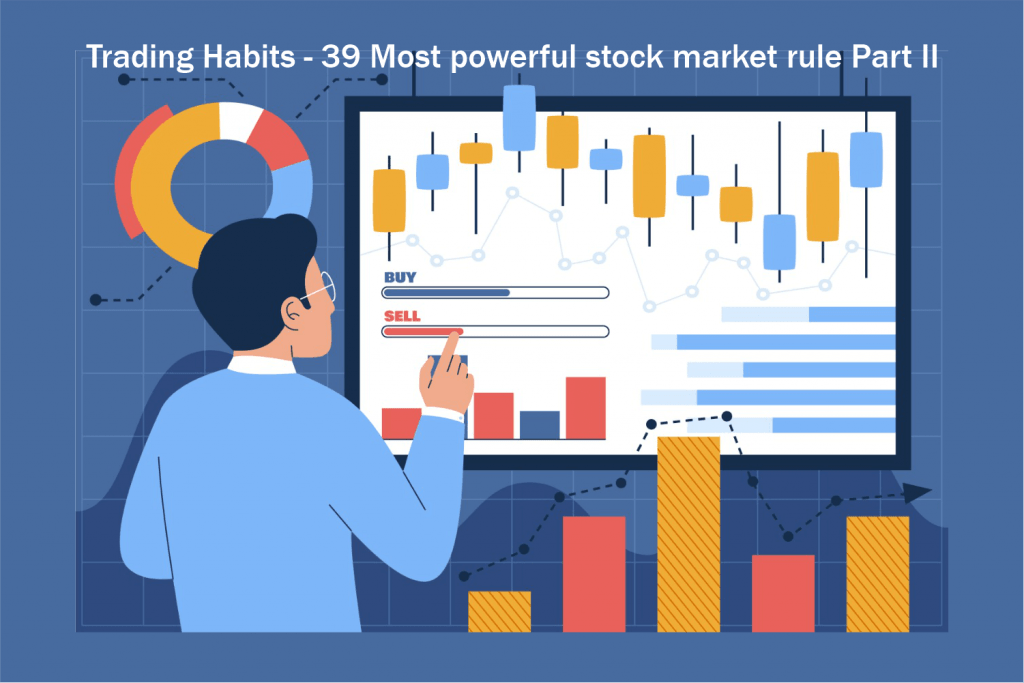This article is the summary of the book “Trading Habits- 39 Most Powerful Stock Market Rules” By Steve Burns & Holly Burns. The article is divided into three parts based on its major segments and we will discuss rules 16 to 27 in this part.
If You missed the first two parts of this summary then check the below links:
Trading 39 Most Powerful Stock Market Rules Part 1
Trading Rule 16-27 Part 2
Mind Over Emotion
16. Wishful thinking must be banished. – Jesse Livermore
Hope is a dangerous emotion in the stock market. Hope for a big winning trade causes people to take position sizes that are too large. The stronger the hope of turning a small account into a big account, the greater the chance that a trader engages in risky trades and takes their small account to zero. These kinds of wishful thinking trading habits are not favorable if you want to increase profitability.
17. Money is made by discounting the obvious and betting on the unexpected. – George Soros
The obvious trades that everyone thinks are a no-brainer, usually don’t work because when a trade becomes obvious, it’s too late. Obvious or unexpected aren’t trading signals, so you need to look for technical signals that line up with the extreme market sentiment.
18. A losing trade costs you money, but letting a losing trade get too far out of hand can cause you to lose your nerve. Cut losses for the sake of your nerves and your capital.
A trader can come back after losing money, and losses happen. Letting a small loss turn into a big loss is expensive both financially and emotionally. If you want to be a trader for the long haul, you must always take the small loss where you planned.
19. Never trade position sizes so large that your emotions take over your trading plan.
Many traders have to build up larger position sizes over some time. Because the stress of trading and risking their capital creates unpleasant reactions. You can’t trade with a position size that impedes your ability to follow your trading plan. Find the size that removes the emotional dynamic from your trading.
20. Trade the market, not the money. – Richard Weissman
Trading decisions should be made based on price action, not the need to make money. Profits must be set at technical levels of resistance but not on your profit target. A stop-loss must be based on the price level that you’ve proven wrong, not at the level where you’ve lost all you can stand to lose.
21. When there’s nothing to do, do nothing. – Richard Weissman
Traders lose money by entering trades they shouldn’t due to boredom or because they’re trying to make something happen. The motivation for taking a trade should be a good signal with a good risk/reward ratio and probability of success. Bad trades are usually because a trader is impatient and wants to make money as quickly as possible.
22. Trade what’s happening…not what you think is gonna happen. – Doug Gregory
Predicting is trying to forecast where prices will go in the future. Reactive trading is based on taking a trade after a signal has indicated the beginning of a trend. It is predictive to believe that the stock market is coming out of a bear market and buy based on that belief.
23. Develop systems based on the kinds of “pain” (weaknesses) endured when they aren’t working or you’ll abandon them during drawdowns. – Richard Weissman
Structure your trading so you have a low probability of being broken by a single drawdown. If you want your max drawdown from equity high to be 5%. Then your risk per trade needs to be 1% per trade. Design your trading system with position sizing and risk exposure in a way that you never reach your breaking point.
24. Remain flexible and go with the flow of the market price action. Stubbornness, egos, and emotions are the worst indicators for entries and exits.
Traders should focus on finding the trend, and then trading in the direction of its accumulation or distribution. Emotions and egos are the worst trading signals. Successful traders identify what kind of market they are in and trade the price action as it unfolds.
25. A trader can only be successful after they have faith in themselves as a trader, their trading system as a winner, and know that they will remain disciplined.
The biggest reason new traders fail is that they put confidence in their trading abilities before they have any competence in trading. You must have a trading system with an edge, you must manage your risk, and you must have the self-control to avoid blowing up your account.
You need to implement these trading habits as a discipline.
26. One thing I have learned over the years of trading is that crisis opportunity. – Dean Karrys
The best margin of safety for value. investors looking to buy into individual stocks at great valuations usually occur during a crisis in the market. Sell short early, buy the fear later, and sell the relief rally when the world doesn’t end. Ask yourself where the best risk/reward ratios lie in selling short, buying the deep dip, and trading reversals and gaps.
Now we are at the end of our second part of these powerful trading habits.
27. Going up on bad news or down on good news is among the strongest market tells. – Richard Weissman
If $SPY rallied off the 30 RSI on bad news inside a long-term uptrend, it would reinforce the trade setup and give more confidence in a sustained bounce. The news itself is not a signal, but it can be combined with a trading signal to reinforce a trade’s viability.
Check Out the next part of this powerful trading habits summary,

